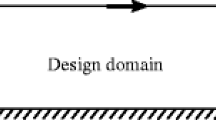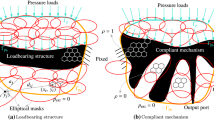Abstract
When a structure under design-dependent pressure loads is being topologically optimized, the magnitude and/or direction of these loads may change as the structure’s topology is being updated simultaneously. Therefore, two critical aspects in the optimization to be addressed are the identification of changing topological boundaries and the correct application of pressure loads to newly formed pressure surfaces. In this study, we present a simple boundary identification and load evolution (BILE) model to resolve these aspects. As the name suggests, a boundary identification step utilizes a threshold volume fraction to define topological boundaries and a load evolution step that occurs for a number of iterations between two successive boundary identification iterations. This model is particularly attractive because of its ease of application and computational cost-effectiveness as most numerical results for 2D problems using 5000 to 13,000 isoparametric quad elements were obtained under 90 s and 100 iterations using the optimality criteria method (OCM). Based on the modified SIMP method, this model is compared with existing methodologies by presenting several numerical examples for validation.

























Similar content being viewed by others
References
Amir O, Mass Y (2018) Topology optimization for staged construction. Struct Multidiscip Optim 57(4):1679–1694
Andreassen E, Clausen A, Schevenels M, Lazarov BS, Sigmund O (2011) Efficient topology optimization in MATLAB using 88 lines of code. Struct Multidiscip Optim 43(1):1–16
Bendsøe MP, Kikuchi N (1988) Generating optimal topologies in structural design using a homogenization method. Comput Methods Appl Mech Eng 71(2):197–224
Bruggi M, Cinquini C (2009) An alternative truly-mixed formulation to solve pressure load problems in topology optimization. Comput Methods Appl Mech Eng 198(17–20):1500–1512
Bruns TE (2005) A reevaluation of the SIMP method with filtering and an alternative formulation for solid-void topology optimization. Struct Multidiscip Optim 30(6):428–436
Chen B, Kikuchi N (2001) Topology optimization with design-dependent loads. Finite Elem Anal Des 37:57–70
Deaton J D, Grandhi R V (2013) Stress-based topology optimization of thermal structures. 10 the World Congr. Struct. Multidiscip. Optim., pp. 1–10
Dems K, Mroz Z (1983) Variational approach by means of adjoint systems to structural optimization and sensitivity analysis-i. Int J Solids Struct 19(8):677–692
Du J, Olhoff N (2004) Topological optimization of continuum structures with design-dependent surface loading – part I : a new computational approach for 2D problems. Struct Multidiscip Optim 165(April):151–165
Du Y, Luo Z, Tian Q, Chen L (2009) Topology optimization for thermo-mechanical compliant actuators using mesh-free methods. Eng Optim 41(8):753–772
Gao T, Zhang W (2010) Topology optimization involving thermo-elastic stress loads. Struct Multidiscip Optim 42(5):725–738
Hammer VB, Olhoff N (2000) Topology optimization of continuum structures subjected to pressure loading. Struct Multidiscip Optim 19(2):85–92
Hassani B, Hinton E (1999) Homogenization and structural topology optimization. Springer
Hou J, Zhu JH, Li Q (2016) On the topology optimization of elastic supporting structures under thermomechanical loads. Int J Aerosp Eng 2016:7372603
Kumar P, Langelaar JSFM (2020) Topology optimization of fluidic pressure-loaded structures and compliant mechanisms using the Darcy method. Struct Multidiscip Optim 61(4):1637–1655
Lee E, Martins JRRA (2012) Structural topology optimization with design-dependent pressure loads. Struct Multidiscip Optim 53(5):1005–1018
Lee E, James KA, Martins JRRA (2012) Stress-constrained topology optimization with design-dependent loading. Struct Multidiscip Optim 46(5):647–661
Li Q, Steven GP, Xie YM (2001) Thermoelastic topology optimization for problems with varying temperature fields. J Therm Stress 24(4):347–366
Li Z, Yu J, Yu Y, Xu LX (2018) Topology optimization of pressure structures based on regional contour tracking technology. Struct Multidiscip Optim 58(2):687–700
Liang C, Shiah S, Jen C, Chen H (2004) Optimum design of multiple intersecting spheres deep-submerged pressure hull. Ocean Eng 31:177–199
Meli E, Rindi A (2017) Detc2017-67061 Innovative structural topology optimization approach for rotordynamics components using innovative materials and new. ASME 2017 Int. Des. Eng. Tech. Conf. Comput. Inf. Eng. Conf., vol. DETC2017-6, pp. 1–11, 2017
Niu C, Zhang W, Gao T (2019) Topology optimization of continuum structures for the uniformity of contact pressures. Struct Multidiscip Optim 60(1):185–210
Picelli R, Kim ANHA (2019) Topology optimization for design-dependent hydrostatic pressure loading via the level-set method. Struct Multidiscip Optim:1313–1326
Picelli R, van Dijk R, Vicente WM, Pavanello R, Langelaar M, van Keulen F (2017) Topology optimization for submerged buoyant structures. Eng Optim 49(1):1–21
Rozvany GIN (2009) A critical review of established methods of structural topology optimization. Struct Multidiscip Optim 37(3):217–237
Rozvany GIN, Zhou M, Birker T (1992) Generalized shape optimization without homogenization. Struct Optim 4(3–4):250–252
Sigmund O, Clausen PM (2007) Topology optimization using a mixed formulation: an alternative way to solve pressure load problems. Comput Methods Appl Mech Eng 196(13–16):1874–1889
Svanberg K (2007) MMA and GCMMA – two methods for nonlinear optimization. Optim Syst Theory 1:1–15
Tortorelli DA, Michaleris P (Oct. 1994) Design sensitivity analysis: overview and review. Inverse Prob Eng 1(1):71–105
Vantyghem G, Boel V, Steeman M, De Corte W (2019) Multi-material topology optimization involving simultaneous structural and thermal analyses. Struct Multidiscip Optim 59(3):731–743
Wang MY, Wang X, Guo D (2003) A level set method for structural topology optimization. Comput Methods Appl Mech Eng 192:227–246
Wang C, Zhao M, Ge T (2016a) Structural topology optimization with design-dependent pressure loads. Struct Multidiscip Optim 53(5):1005–1018
Wang C, Zhao M, Ge T (2016b) Structural topology optimization with design-dependent pressure loads. Struct Multidiscip Optim:1005–1018
Wang C, Zhao M, Ge T (2016c) Structural topology optimization with design-dependent pressure loads. Struct Multidiscip Optim 53(5):1005–1018
Xie YM, Steven GP (2006) Technical note: a simple evolutionary procedure structural optimization. Comput Struct 49(5):885–896
Zhang W, Zhao L, Gao T (2017) CBS-based topology optimization including design-dependent body loads. Comput Methods Appl Mech Eng 322:1–22
Zheng B (2006) Detc2006-99749 Topology optimization considering gravitational
Zheng B, Chang CJ, Gea HC (2009) Topology optimization with design-dependent pressure loading. Struct Multidiscip Optim 38(6):535–543
Funding
This work was supported by funding from the Natural Sciences and Engineering Research Council of Canada (NSERC), the Federal Economic Development Agency for Southern Ontario (FedDev Ontario), Siemens Canada Limited, and Petroleum Technology Development Agency (PTDF).
Author information
Authors and Affiliations
Corresponding author
Ethics declarations
Conflict of interest
The authors declare that they have no conflict of interest.
Replication of results
The steps in the BILE model have been elaborately explained and can be reproduced by following the workflow presented and ensuring the right values for volume fraction threshold, fth, and number of load evolution steps, nle, are chosen (these are also explained in the result section). Notwithstanding, a sample MATLAB code that implements Example 5.1 has been provided as supplementarymaterial.
Additional information
Responsible Editor: YoonYoung Kim
Electronic supplementary material
ESM 1
(m 19.5 kb).
Rights and permissions
About this article
Cite this article
Ibhadode, O., Zhang, Z., Rahnama, P. et al. Topology optimization of structures under design-dependent pressure loads by a boundary identification-load evolution (BILE) model. Struct Multidisc Optim 62, 1865–1883 (2020). https://doi.org/10.1007/s00158-020-02582-8
Received:
Revised:
Accepted:
Published:
Issue Date:
DOI: https://doi.org/10.1007/s00158-020-02582-8




